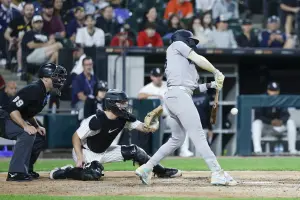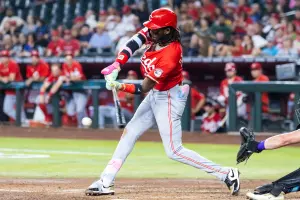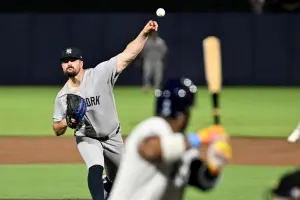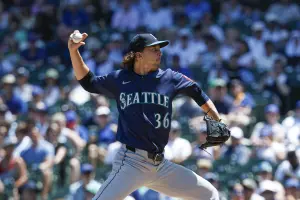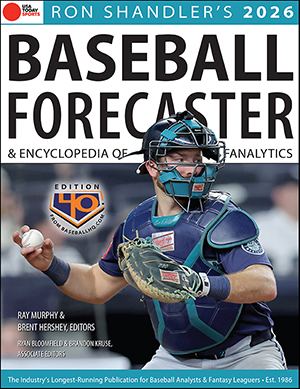
(*) F/F SPOTLIGHT: Mike Moustakas
Fact/Fluke Spotlight was a weekly feature we debuted in 2014. For new readers, Spotlight is a place where a rotation of BaseballHQ.com writers will take a "deep dive" into one player's performance, using our traditional Fact/Fluke approach, but also incorporate other more detailed tools. Starting next week, this feature will appear each Monday on the site. Enjoy. —Ed.
Mike Moustakas (3B, KC) was beginning to test our patience. Highly-touted since his half-season debut in 2011, Mosutakas had delivered sub-par batting averages in his three-and-a-half seasons, left-handed pitching gave him fits, it seemed like he struck out too much, and his much-ballyhooed power from his minor league days had not transitioned to the majors. Though there were glimpses of him turning the corner—most notably a post-season in 2014 in which he hit five home runs in 52 AB—these were usually short-lived and he soon returned to a disappointingly mediocre level of performance..
But four weeks into the 2015 season, Moustakas is hitting like the star that many had him pegged to be, and has helped to lead the Royals to a 16-9 record. We've seen these stints before—Is the stretch just another small-sample tease, or has something changed that might make us believe this level is sustainable?
Year AB BA xBA bb% ct% Eye h% PX xPX HctX G/L/F hr/f HR ==== === ==== ==== === === ==== == === === ==== ======== ==== == 2011 338 .263 .245 6% 85% 0.43 30 73 83 94 38/20/41 4% 5 2012 563 .242 .236 6% 78% 0.31 28 115 109 88 34/16/50 9% 20 2013 472 .233 .241 6% 82% 0.39 26 91 86 84 37/19/45 7% 12 2014 457 .212 .259 7% 84% 0.47 22 99 120 115 39/20/41 9% 15 2015 102 .324 .285 4% 89% 0.36 34 90 84 92 40/22/37 9% 3
Looking just at these numbers in isolation, there is some reason to believe the latter:
First, perhaps the BPI that stands out most clearly in this five-season scan is Moustakas’ contact rate. After dipping to 78% in 2012, it has improved significantly each season since then, topping out at 89% though a bit more than 100 plate appearances so far. Though his batting average coming in to 2015 had actually gone down over that time, his xBA mirrors his steady improvement in plate skills.
Second, his out-of-character hit rate in 2015 has to be factored in, though its effect is not as straightforward as it may seem. On the one hand, compared to his prior three-year average, 34% is an outlier, one that we would expect to correct as the season goes on, to the detriment of his counting stats. But on the other hand, when taken in tandem with a multi-year improvement in making contact, perhaps it’s not quite the outlier it may seem. Does the fact that Moustakas has proven to strike out less in recent seasons mitigate the effect of the hit rate?
Third, add Moustakas’ line-drive history to this equation. Much like contact rate, his LD rate has improved for third season in a row—taking it from poor place (2012's 16%) to a good one in 2015. The increase in both contact rate and line-drive rate—both core hitting skills—over three consecutive seasons is in best-case-scenario territory for a young player.
So while no, Moustakas is unlikely to hit nearly .330s the rest of the way, there are some foundational pieces in place to build on.
Expectations and early career
Upon his promotion, Moustakas was an established, elite prospect. He had led the minor leagues with 36 home runs over two levels in 2010, and entered 2011 comfortably in the Top 10 overall in most prospect lists. He garned a lofty 9B prospect rating from BaseballHQ.com coming into the 2011 season. Though he didn’t set Triple-A on fire that year (.845 OPS, 10 HR in 250 AB), the Royals called him up in June of that season and he experienced some immediate success. He finished with a .263 BA, 85% ct%, though in a tease of things to come, his power was a bit disappointing (5 HR).
But one area of continual struggle in his early years was his ineptitude against left-handed pitching. Yes, in 2013 and 2014 a poor hit rate helped do him in, but his struggles against southpaws was getting to the point at which one began to wonder if a low hit rate was just Moustakas' reality. Even as his ct% rose against both lefties and righties, poor hit rate held him under the Mendoza line against LHP in three of his first four seasons:
Year Split AB HR BA OBP SLG OPS bb% ct% Eye h% PX
==== ====== === == ==== ==== ==== ==== === === ==== == ===
2011 vs LHP 89 0 .191 .258 .236 .494 7% 83% 0.47 23 41
vs RHP 249 5 .289 .327 .414 .741 6% 86% 0.42 32 85
-----------------------------------------------------------------------------------
2012 vs LHP 169 4 .254 .296 .408 .704 6% 76% 0.24 31 113
vs RHP 394 16 .236 .297 .414 .710 7% 79% 0.35 26 116
-----------------------------------------------------------------------------------
2013 vs LHP 107 2 .196 .256 .290 .546 8% 79% 0.39 23 67
vs RHP 365 10 .244 .295 .386 .682 6% 84% 0.38 27 98
-----------------------------------------------------------------------------------
2014 vs LHP 99 3 .172 .241 .313 .554 7% 84% 0.50 18 97
vs RHP 358 12 .223 .279 .374 .653 7% 84% 0.47 24 100Because of this hole against southpaws, it was easy to pigeonhole Moustakas as one who might never fufill the promise of his prospect status. Maybe he would be just another one-sided low-BA slugger; was it time to introduce the "p" word ("platoon"), even at his young age?
But four weeks in, Moustakas' improvement against LHP is stunning, and it's not just about his hit rate correction:
Year Split AB HR BA OBP SLG OPS bb% ct% Eye h% PX
==== ====== === == ==== ==== ==== ==== === === ==== == ===
2015 vs LHP 48 1 .313 .389 .458 .847 2% 94% 0.33 32 93
vs RHP 54 2 .333 .379 .481 .861 5% 85% 0.38 36 87
At this juncture, it's his contact rate against LHP that is driving his overall improvement. He's cut down on his strikeouts, and though his HR total is still meager, his slugging percentage also stands at a career best.
Adjustments low in the zone
As we look a bit deeper, one area Moustakas has handled much better in the early going in 2015 is pitches low in the zone. During the first four weeks of play, Moustakas has made contact on these pitches at a much higher rate than previously. Via brooksbaseball.net, observe the following graphics: First, his whiff percentage (swings and misses on pitches in each part of the zone) from 2011-2014. Notice his high swing-and-miss rate in the low-middle and low-outside sections both in and out of the strike zone (identified by the thin gray line):
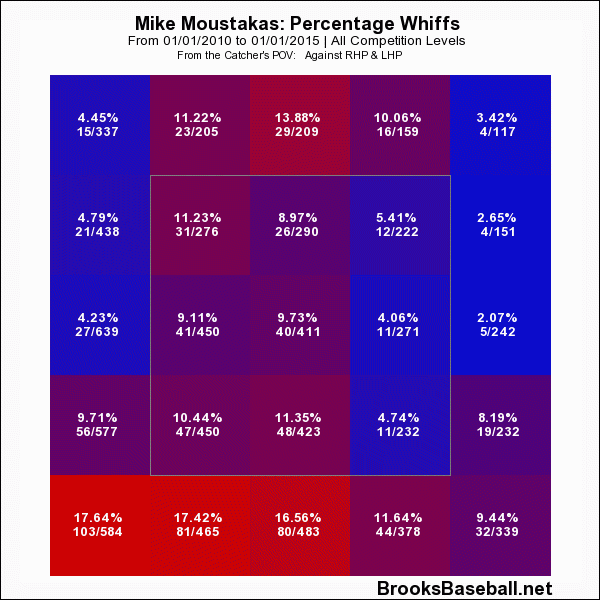
By contrast, the whiff percentages have dropped over those same areas in 2015. For whatever reason, Moustakas is getting the bat on the ball, and not swinging through pitches in the zones that had given him problems in the past:
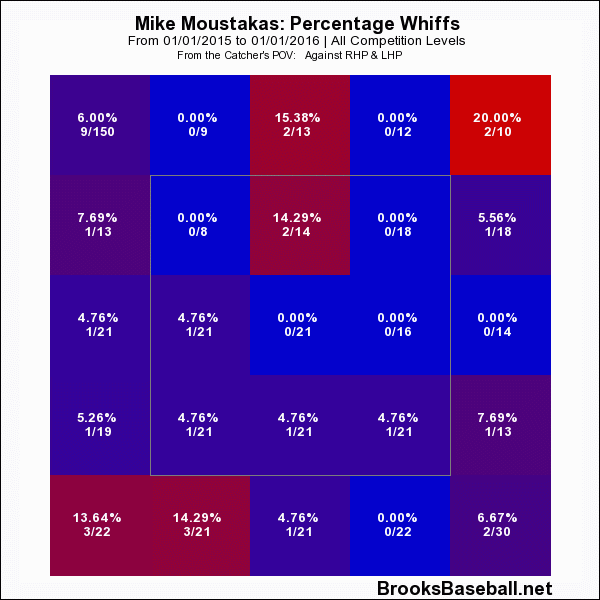
In fact, though the difference is most obvious in the lower part of the zone, Moustakas is making contact with pitches to all parts of the plate. According to this chart, he's missed just six of the first 161 strikes thrown to him this season. Given these figures, the explanations could be either a conscious area of emphasis for Moustakas—or else it's a crazy-lucky hot streak. But so far, the bottom line is that pitchers who previously could garner swings/misses in the lower third of the strikezone and below are not able to get Moustakas to bite in 2105. It's still early in the season, but whiffing far less than previously has to be considered a big factor in his fast start.
Contact questions and using the whole field
So Moustakas is making better contact, especially with pitches down in the zone. But what is happening to that contact? There are a couple conflicting data sets.
Overall, though Moustakas is making more contact, it doesn't seem he's making harder contact. Our data provider, Baseball Info Solutions, categorizes each batted ball as hard/medium/soft, and historical figures are recorded in the "Misc" tab of each hitter's PlayerLink page. Moustakas' chart from 2012 to the present:
Year Hard% Med% Soft% AvFB dist* ==== ===== ==== ===== ========= 2012 26% 55% 19% 279 ft. 2013 25% 54% 21% 270 ft. 2014 32% 47% 22% 283 ft. 2015 24% 47% 29% 265 ft. *via baseballheatmaps.com
Though his increase in hard% was promising in 2014, it has settled back to his average range from 2012 and 2013. And the decrease in hard% has shown up as an increase in soft% in 2015. So a larger percentage of his batted balls are "soft." In addition, his average distance on fly balls (by which a spike in feet can be an indication of a future increase in HR) has declined in 2015—to a career-low mark, in fact. Both would paint a less-rosy picture of his early 2015 success.
The question, though, becomes: is softer contact and (and less FB distance) better than no contact at all?
Maybe. Especially when one considers how Moustakas has better used the whole field in 2015. Here's Moustakas’ spray chart from 2014:
Mike Moustakas_2014all_spray.png" style="height: 385px; width: 575px;" />
A couple things stand out: First, all of Moustakas’ 2014 home runs were pulled over the right field fence. When he went long in 2014, it was all to his pull field. Second, a majority of his batted balls to the OF that resulted in hits were also to right field. Third, it sure looks like he hit a lot of pop-outs just beyond the infield,—which could point to not hitting the ball squarely, or simply his timing being off.
Now check out the same chart, circa 2015:
Mike Moustakas_2015all_spray.png" style="height: 385px; width: 575px;" />
This is in-progress, of course, with approximately one-sixth of the data set as the above. But, Moustakas already has one opposite-field HR, he has a bunch of singles dropped into left field (might they be softly hit?), and though there are still some IF pops, they don’t seem to be occurring as frequently as they did in 2014. Early data seems to indicate that Moustakas is doing a better job of using the whole field.
That argument is strengthened when we examine his spray charts against left-handed pitching, his nemesis up to this year. First, from ABs against LHP in 2014:
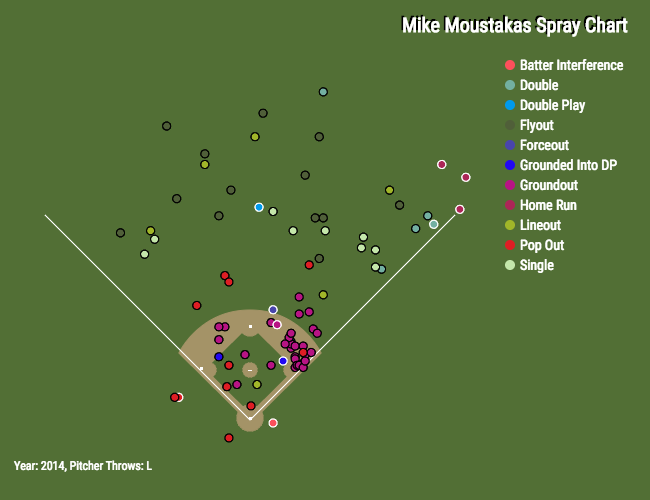
Like his 2014 chart above, batted balls that reached the OF were most often hit to his pull side against LHP. But in 2015:
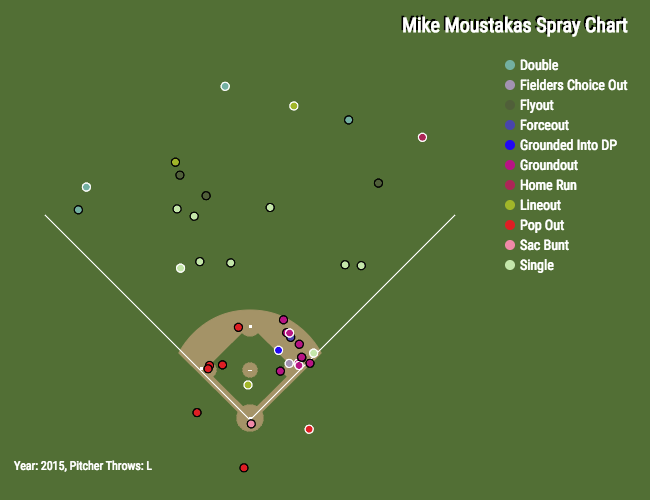
Again, the sample size is tiny. But so far, Moustakas is going the other way with balls that reached the outfield off of LHP.
Other factors
Several other points can’t be quantified in the same way as the data above, but perhaps have played a factor in his early 2015 success.
Moustakas has batted in the #2 lineup position in all of his 25 games through Sunday. This, after spending the bulk of his previous career hitting anywhere from #5 to #8 in the order. He still seems like a dubious choice for a #2 hitter: as noted above, he had early career swing-and-miss tendencies, and up through last season, had extreme trouble with left-handed pitching. Yet from a statistical standpoint, he has taken off from the #2 hole.
So chicken/egg question remains: did manager Ned Yost or others in the organization see something in spring training that led them to believe he could hit out of the two-hole? Of, was he placed there and Moustakas himself adjusted his game to make better contact to move runners along, etc.? Whatever the answer, his success probably means that he'll remain at that spot in the lineup for the time being..
Related, other teams shifted against Moustakas quite frequently in the past. Is his new-found ability to go the other way in direct response to the shift? Did he make intentional adjustments to both make better contact and force defenses to be more honest? These are the questions that the rest of the season will help to answer from a purely statistical perspective.
Conclusion
Interestingly, early on in his career Mike Moustakas was always thought of a high-power, low-BA type, even though his minor-league numbers showed that he wasn't necessarily a strikeout machine. And even with his 2015 success, his power metrics still sit right at league average; they have not improved in the same manner his other batted-ball and splits numbers have. But Moustakas has shown big power in his past with the ability to drive the ball into the gaps and over the opposite-field wall.
At 26 years old, it’s worth acknowledging that Moustakas still is an unfinished product—there are points in his 2015 start in which he looks like a different player than his past. But if these steps of making more consistent contact and using the whole field set a baseline and help to unlock his power, Moustakas would make for a quite attractive player, both in real life and in fantasy.
Because you can’t smack extra-base hits on a swing-and-miss.
Need more? A BaseballHQ.com subscription unlocks articles like these, seven days a week. Winning. Fantasy baseball. Insight.


